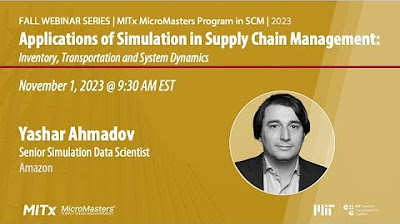From Automated to Autonomous Supply Chains
Summary
TLDR在这段视频脚本中,Inma Borrella,MIT运输与物流中心的研究科学家,与Laura Allegue共同主持了一场关于供应链数字化转型的直播活动。他们邀请了英特尔公司的高级首席AI工程师Dr. Mani Janakiram,分享了英特尔在自动化供应链向自主供应链转型过程中的经验。Mani讨论了数字化转型的必要性,展示了英特尔如何利用人工智能、物联网和大数据来提高供应链的可视性、敏捷性和韧性。他还强调了文化变革的重要性,以及如何通过数据和分析来优化供应链流程。此外,Mani还提到了英特尔在可持续性方面的努力,包括水资源管理和可再生能源的使用。最后,他为那些希望开始数字化转型之旅的公司提供了建议,强调了从解决实际问题出发,逐步采用技术,并最终实现颠覆性创新的重要性。
Takeaways
- 🌟 供应链数字化是英特尔公司的关键战略支柱,它通过提高客户满意度、增强供应链的敏捷性和韧性,以及降低成本和复杂性,帮助公司实现长期目标。
- 📈 英特尔利用先进的数据分析和人工智能技术,如预测分析、物联网(IoT)、自然语言处理(NLP)和机器学习(ML),来优化其供应链管理。
- 🚀 英特尔的供应链转型旅程是从自动化到自主化的连续过程,公司正在积极开发和实施新的AI能力,以提高端到端的供应链可见性和行动性分析。
- 🤖 机器人流程自动化(RPA)和AI在简化和标准化业务流程中发挥着重要作用,它们使英特尔能够更智能地自动化任务,提高效率。
- 🌐 英特尔的全球供应链非常复杂,涉及大量的数据和设备,公司通过数字化转型来提高其供应链的智能化水平,以应对这一挑战。
- ♻️ 英特尔在可持续性方面也取得了进展,通过数字化工具监控水资源使用,实现高比例的回收,并利用太阳能农场等替代能源。
- 🛠️ 英特尔作为领先的半导体解决方案供应商,正在通过扩展其集成设备制造(IDM)能力,包括外部代工厂的合作,来支持其供应链的扩展。
- 📊 数字孪生技术允许英特尔在产品开发和供应链规划中进行模拟和优化,这有助于公司在不牺牲质量的前提下,缩短产品上市时间。
- 🧐 英特尔强调在进行数字化转型时,需要进行文化变革,包括愿意放弃旧的工作方式,接受新技术,并在整个组织中建立信任和合作。
- 📉 面对COVID-19大流行期间的半导体短缺问题,英特尔利用数字工具进行风险管理和缓解,确保了业务连续性和供应链的韧性。
- ⏱️ 英特尔认为,尽管自动化和自主化技术将在未来发挥更大作用,但人类干预在可预见的未来仍然是供应链管理中不可或缺的一部分。
Q & A
Inma Borrella在MIT的哪个中心担任研究科学家?
-Inma Borrella是麻省理工学院(MIT)交通与物流中心的研究科学家。
Dr. Mani Janakiram在英特尔公司担任什么职位?
-Dr. Mani Janakiram是英特尔公司的高级首席人工智能工程师,负责制造业供应链运营。
数字化转型在供应链中的作用是什么?
-数字化转型在供应链中的作用是通过利用数字工具和技术提高供应链的效率和敏捷性,降低复杂性和成本,增强生产力和韧性。
英特尔是如何支持全球自主运营的?
-英特尔通过提供半导体技术,支持计算、连接性、云计算以及人工智能的快速发展,从而支持全球自主运营。
为什么数字化转型现在发生,并且呈现出指数级增长?
-数字化转型现在发生并呈现指数级增长的原因是数据与物联网的融合、数据收集技术的进步、存储的可负担性、计算能力的提升以及人工智能和机器学习算法的发展。
人工智能在供应链转型中扮演什么角色?
-人工智能在供应链转型中扮演着使能者的角色,它可以帮助感知、推理、行动,并与系统和生态系统进行交互,提高供应链的速度、敏捷性和生产力。
英特尔如何利用其供应链的复杂性和规模?
-英特尔通过全球内部工厂网络进行规模化制造,并利用第三方代工厂扩大产能。它还通过数字化和人工智能技术优化供应链,提高效率和响应能力。
英特尔如何管理其庞大的供应链和供应商网络?
-英特尔通过使用先进的数据分析、人工智能模型和机器学习算法来优化其供应链。它还利用认知网络爬虫技术来主动管理风险并保持供应链的韧性。
英特尔如何从手动过渡到自动化,最终实现自主供应链?
-英特尔通过简化、标准化、自动化、智能化和自主化的步骤来过渡其供应链。它利用数字孪生、模拟和优化模型来预测和规划其供应链网络。
英特尔如何利用数字工具来应对COVID-19期间的半导体短缺问题?
-英特尔利用实时数据可视化、预测分析、库存优化模型和物流优化来应对COVID-19期间的半导体短缺问题。
在数字化转型过程中,英特尔如何衡量自动化水平和评估进展?
-英特尔通过关键挑战、战略目标、项目治理模型、项目里程碑和价值影响来衡量自动化水平和评估进展。它还使用中心卓越和定期审查来确保项目的成功实施。
Outlines

This section is available to paid users only. Please upgrade to access this part.
Upgrade NowMindmap

This section is available to paid users only. Please upgrade to access this part.
Upgrade NowKeywords

This section is available to paid users only. Please upgrade to access this part.
Upgrade NowHighlights

This section is available to paid users only. Please upgrade to access this part.
Upgrade NowTranscripts

This section is available to paid users only. Please upgrade to access this part.
Upgrade NowBrowse More Related Video

Leveraging supply chain optimization and visibility to achieve carbon reduction targets

Applications of Simulation in Supply Chain Management

The Paradox of Digital - people, processes, and technology in SCM

AI-Driven Supply Chains: 3 Cases | MIT SCALE Webinar | Spanish

The Critical Role of Supply Chains in Business and Society

AI-Driven Supply Chains: 3 Cases | MIT SCALE Webinar | English
5.0 / 5 (0 votes)
